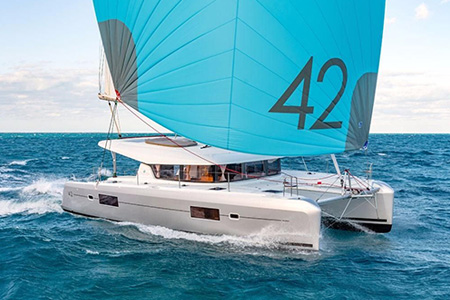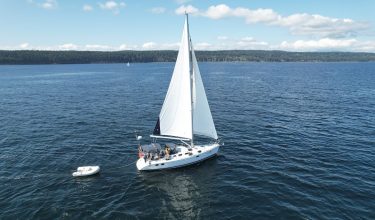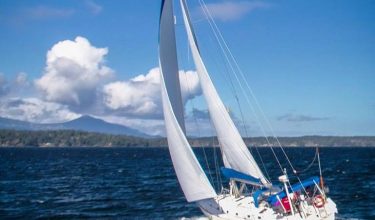 In the Vancouver area, catamarans are popular. They provide easy, flat sailing with access to shallow areas for easy anchoring.
In the Vancouver area, catamarans are popular. They provide easy, flat sailing with access to shallow areas for easy anchoring.
There are 3 main catamaran hull designs:
- Planing – If you want speed rather than comfort then select this hull design. It has a flatter v-bottom surface so these boats get on a plane quickly for maximum speed. The downside is the flat surface of the hull means you feel more of a slamming effect as the boat moves along. This effect isn’t nearly as bad as in a mono-hull.
- Semi-displacement – Wide, oval bottoms on these hulls provide the best lift, stability and load bearing capability. Greater bouyancy allows more sail power and a better balance for comfort. There is little lateral movement and no enhancements are needed to make this hull design perform. It has the widest footprint in the water offering the best stability and speed to comfort ratio. The design allows for large fish boxes, deep storage in hulls and maximum usable space.
- Full displacement – maximum comfort in heavy seas. Tall and narrow hull. This design offers most seaworthiness in rough conditions. A deeper hull, less beam and a larger range of positive stability. However the narrow hull does not allow for maximum load capacity and has more movement than other designs. There is also more movement at rest than other designs due to narrower hull design.
Mono Hull vs Catamaran
Advantages
- A gentler sailing angle. The normal sailing angle for a catamaran is a comfortable 5 to 10 degrees, for a monohull it is about 30 to 45 degrees. It means a catamaran is a more relaxed sailing position and there is less need to have everything stowed away. Monohulls are designed to plane at a particular speed and weight distribution. As weight increases and/or speed decreases, the stern settles, creating untrimmed conditions. As the boat pushes forwards, it creates a “hill” of water. In this bow-high position visibility is limited and the hull bottom is pounded. However, a cat avoids this condition rising and falling evenly in the water as speed and/or weight distribution adjusts.
- More sail and different hull shape makes them faster. Catamarans are more stable than monohulls so designers can use more sail per foot of the boat. The stability comes from the wide beam of the boat. This wide beam and stability allows catamarans to gain more power from the wind in their sails because they do not heel over like monohulls and so there is more boat in the water to power boat speed.
- Shallow draft. With a catamaran you have a way shallower draft than a monohull which means you can anchor closer to the beach. Your cruising ground is significantly extended.
- Easy anchoring. With a catamaran you can anchor in shallower areas. Shallow anchoring means you are more likely to be in a sheltered spot and less water means less swell which means a more comfortable sleep.
- Clean the bottom of your boat without paying for it to be hauled out. Find somewhere suitable which is tidal and let your boat sit on its own keels whilst you scrub the bottom.
- Lots more room than a monohull. There is way more usable space on a catamaran both on deck and down below. Having 2 seperate hulls also gives some privacy. Put the children to bed in 1 hull and reserve the other hull for yourselves.
- Better visibility. Most catamarans have 360 degree views from the cockpit and the saloon as a catamaran’s deck is parallel to the water at all speeds. This is a great advantage when maneuvering in tight places and of course in Vancouver it’s always lovely to enjoy all the scenery.
- It’s hard to sink a catamaran…. Unless you have a major fire on board it is always safer to stay with the boat. A damaged or even flipped catamaran is very unlikely to sink because most catamarans are made from closed-cell foam which floats no matter what.
- Catamarans are faster. Catamarans are normally about 20 to 30% faster than a monohull of equivalent size and weight.
- Catamarans have 2 engines. Double the cost, but you have a backup and 2 engines mean far easier maneuvering.
Disadvantages
- The sailing experience. For avid sailors how much space there is down below and how easy the boat is to anchor are secondary to the sailing experience. Feeling the boat heeling and the wind blasting the boat through the sea makes the day. Cruising catamarans provide a more stable, gentle sailing experience which may not be the best sailing experience for everybody.
- Different sailing techniques. A catamaran has a light displacement and high windage which makes tacking different from monohulls and can be tricky until you’ve gotten used to the different techniques. A catamaran cannot point as high as a monhull so you may need to do a slightly longer route to get to your destination.
- Load planning is important. As with any boat the load needs to be carefully spread around the boat.
- Catamarans make more noise. The slamming noise on a catamaran occurs when a boat is going into weather and the waves hit the bridge deck of the catamaran. The amount of slamming noise depends on the height and design of the bridge deck.
- Marina fees are more expensive. A catamaran takes up the space of 2 boats. Anchoring in a quiet shallow bay may be the answer.
Contact us about enjoying a catamaran in Vancouver.











